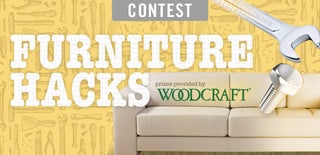Introduction: From Salvaged to Awesome Liquor Display...with Lights
Ahoy there!
In this project, I will show how I have restored a store whiskey display into a two-shelf bar. This poor guy had been abandoned for quite a few weeks by the dumpster at the place where I work. I had thought the design was interesting but the construction and materials were not enough to convince me to grab something I did not really had any use for at the time. Since then, I had to use the desk that was holding my liquor as a workbench and was left with nothing to call a bar. So it was time to save something from the dumpster and get some refurbishing done.
After a ridiculous amount of time trying to fit it in the backseat of my car I learned a valuable lesson: don't try to fit anything longer than 3 feet on a mustang if you can disassemble it. I did that at night, alone, and it took me a long time with no success to realize that the whole thing was held together by 4 screws with loosely attached wing nuts. I felt stupid but then again I was finally on my way home with a future neat lookin' mini bar on hand.
Other than a sturdy half inch plywood base the rest of the display is very lightweight. The barrel walls are a bit less than 1/8'' weak plywood stapled in shape on a pair black MDF rims and two MDF boards, one on the top and one on the bottom of each barrel (see picture).
Overall the structure is sound but the MDF needs hiding as I find it very unappealing. It also sat in the weather for some time before i got it so it had some water damage albeit not an extensive one. Good thing I saved it before more rain got into it.
Step 1: Sanding, Staining and Polishing the Barrel Walls
This instructable will be mainly about touching up on an existing piece of furniture to turn a less than half good-looking thing into an awesome addition to your home. All by using simple and inexpensive materials.
Materials used were:
Beeswax (you'll see this word a lot in here) - Minwax walnut finish - Danish oil - Butcher block conditioner
Tools: Sandpaper, orbital polisher, mini torch, dremel, drill and forstner bit.
As always be careful with flames, don't breathe fumes, use mask, gloves, safety glasses. And of course, have fun.
After disassembling and numbering all the black plastic belts so that the holes would match, I sanded the barrel walls with 220 grit until smooth to the touch.
The barrel body required little sanding, but the faded crude color was definitely not appealing. I applied a walnut stain and polished the two half barrels until they were quite shiny.
Step 2: Sanding and Staining the Base and Barrel Supports
The base needed some sanding to get the water marks from the top. Once finished, I applied the same stain to the top and polished it.
For the mdf barrel beds, beeswax and polisher did the trick to darken up and match the color of the barrels.
Step 3: Shelves
The barrel came with two MDF and plywood shelves. The endgrain on the plywood, as you see on the first picture, was pretty rough and pitted. I didn't want to sand it down because the edge would not be flush with the shelf and I wasn't in the mood for the wood putty filling thing.
I decided that it would look nice to have this edge burned. I did that with a mini propane torch fitted with a heat deflector. After blackening all the surface I filled the holes with beeswax that mixed with the soot, forming a black wax. I then proceeded to wrap a rag around my finger and smooth everything out. The end result was really neat looking and a great improvement over the original appearance.
The front and top of the shelves was then treated with butcher block conditioner. Although simple, it was really effective in bringing out the grain and signage.
Step 4: Some Extra Details
Both barrels are identical, meaning that there is no end cap to hide the MDF and holes that allow for stacking more barrels.
To hide that, I cut a piece of scrap pine with just enough size to snap in the slot and stick out a little bit. To cover the staples, I used very thin scrap strips of pine left from another project and used the same screws that hold the black plastic bands to secure it in place. Everything stained, oiled and buffed as usual.
Step 5: Yet Some More MDF Beeswaxing
The black mdf rims had a pretty unpleasant texture. I was rough and sort of...furry. Since sanding it smooth would remove the black coating, I rubbed a piece of beeswax (I presume a candle would do the trick as well) and buffed it with the polisher. But what really made the difference was hand-rubbing with my finger wrapped in a rag.
A lot of elbow grease went into this step but the result was worth it.
Step 6: Adding Lights!
Here is a step not initially planned. This took me way more time and effort than I conveyed at first, but it totally changed the quality of the project.
I got this 16'' LED rope at wallmart for about 13 bucks and fitted it behind the front rim of both barrels. In order to do that without showing the rope itself I had to carve slots on the top MDF boards while avoiding carving too deep because of staples holding the rim and the crossboard together. And also carve a slots on both sides of the plywood face of the shelves to allow the LED string to go under the shelves. Last, I drilled inconspicuous holes to run the light rope through the 3 parts of the display.
Using a rotary tool with a sanding drum throws a lot of fine dust in your face. Make sure you don't breathe it and use safety glasses.
Step 7: Light It Up!
Yey, after half an afternoon I finally had lights!
It all stayed in place mainly by tension, only the bottom barrel required a few pieces of double sided tape to stay put.
This step is utterly useless but I spent more thinking about it then I would like so it's here just for the sake of completion.
I had 16ft of LED for a display with two 5 1/2 feet diameter barrels. This would give me enough for roughly 3 loops. In order to have the plug coming out of the bottom of the display I made it go clockwise from bottom of the top barrel around to the other side and travel to the back under the shelf and down the hole to the bottom barrel. Then run from the top left to the bottom left and to the front running under the shelf. Counter-clockwise around the bottom barrel and finally down to the base and out to the outlet. Congratulations if you understood this mess of a paragraph. See, told ya it was useless...
Step 8: Fill It Up and Enjoy a Drink!
I really enjoyed working on this and would say it looks and feels better than original. It added a nice warm ambient glow to the living room and is a good conversation piece. Plus it was saved from being trashed.
I hope you liked it too and consider it worthy of a vote!
Take care and drink responsibly!

Participated in the
Furniture Hacks Contest

Participated in the
Leftovers Challenge

Participated in the
Make It Glow! Contest











